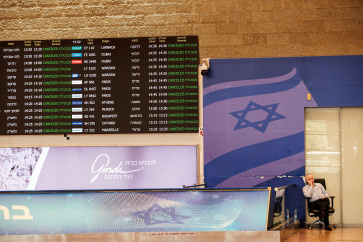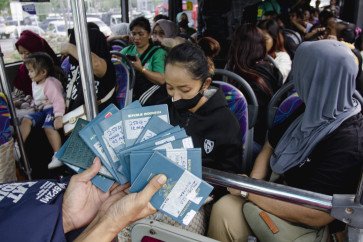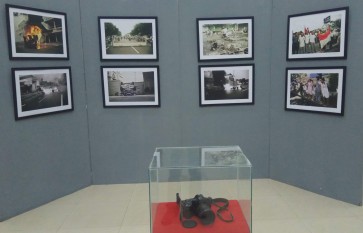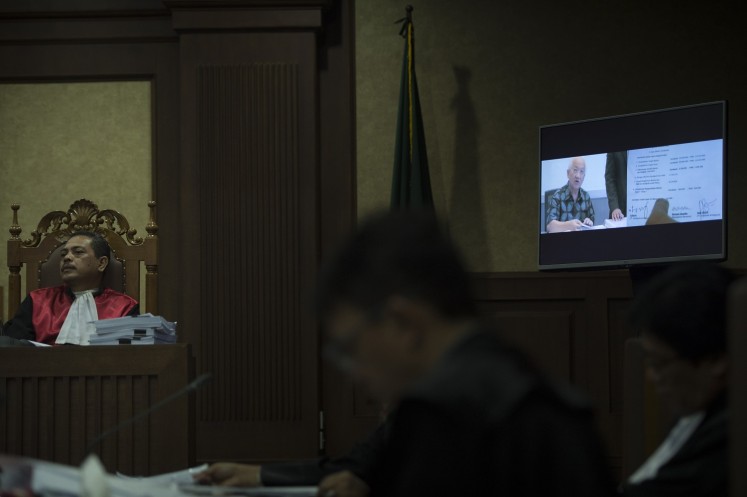Popular Reads
Top Results
Can't find what you're looking for?
View all search resultsPopular Reads
Top Results
Can't find what you're looking for?
View all search resultsJakarta inundated with proliferating ills
Already confronted with an absence of clear-cut policies by the Jakarta administration to address poor living conditions, the worsening traffic situation and an overflowing population, the Big Durian also lacks any solution for the uncontrollable prostitution and the growing number of street children
Change text size
Gift Premium Articles
to Anyone

A
lready confronted with an absence of clear-cut policies by the Jakarta administration to address poor living conditions, the worsening traffic situation and an overflowing population, the Big Durian also lacks any solution for the uncontrollable prostitution and the growing number of street children. A team of The Jakarta Post’s journalists explored the issue. Here are the stories:
Erotic female dancers are up for grabs for any passerby seeking a partner to dance with to dangdut music, while dozens of sex workers — including transvestites — and their pimps roam the vicinity to net customers.
A cheap mix of alcoholic drinks, on-the-street massage services and low-quality marijuana and crystal meth are easily available on the spot. Expose
These worldly pleasures are available at the Cipinang “one-stop service” evening entertainment spot for low-income Jakartans.
Located along a section of Jl. Cipinang in East Jakarta — between the Jatinegara train station and the Cipinang penitentiary — the area is a busy place for street vendors coming from outside Jakarta during the day.
But at night, it is a quintessential red light district.
Although prostitution is illegal in Indonesia — a country home to the world’s largest Muslim population, several police officers, either on their patrol motorcycles or in cars, could regularly be seen stopping. Reporters witnessed exchanges being made, although the specifics of the transactions were unclear.
Cipinang is one example of a new red-light district flourishing in the past five years, indicating a failure by the local administration to at least reduce or control prostitution businesses.
Such areas and brothels — operating either openly or camouflaged as massage and spa parlors or beauty centers — can now be found in nearly every corner of Jakarta.
Prostitutes can also be easily found standing along streets near the Presidential Palace and the National Police Headquarters, or waiting for customers at bars inside lavish hotels and nightclubs.
As Jakarta is littered with prostitutes, there is absolutely everything for everyone. For high-income people, places such as Kota, Jl. Gajah Mada and Jl. Harmoni in Central Jakarta are havens for those seeking such pleasures.
There is also Jakarta’s largest red-light district of Kalijodo, located on the border of West Jakarta and North Jakarta, which is probably the oldest site in Indonesia, as it has been around since the 18th century.
For those of a lower-income, however, there are numerous hunting grounds, and Cipinang is the latest on the list of Jakarta’s underbelly.
According to local residents, prostitution has been in Cipinang since as early as 1993, centering in a park near the Jatinegara station.
“There used to be only transgendered prostitutes here,” recalled Ukim, a street vendor operating near the station.
But public order officers had driven them out four years ago, he said.
“Such measures eventually failed to deter the business, as the transvestites, along with female prostitutes, moved to sidewalks to net customers,” said Ukim.
Every night, from around 8 p.m. until around 3 a.m., young girls below 20 years of age, dressed in alluring outfits, lined the sidewalks to lure customers.
One girl, no older than 12, could be seen roaming around looking for customers. Most of the prostitutes are from Indramayu, a coastal city in northern West Java.
The prostitutes charge customers around Rp 50,000 (US$5.7) for a short time in a small tent beside the railways near the Jatinegara station, or Rp 250,000 in nearby lodges.
Another infamous red-light district is Bongkaran in Tanah Abang, Central Jakarta — only few meters from the Tanah railway station, the iconic Tanah Abang traditional market, the Jakarta textile museum and a police post. The area is also two kilometers away from the headquarters of notorious hard-line group the Islam Defender Front (FPI) on Jl. Pejompongan. The FPI has regularly used violence to crack down on places they deemed against Islamic values such as bars, clubs and karaoke parlors.
Sexual transactions at Bongkaran take place day and night in shabby shacks along the railway or in cheap hotels nearby. The area has existed since the 1960s, and attracts high-income people as well. When The Jakarta Post was recently on site, a black Toyota Alphard was seen picking up a young prostitute and taking her to a nearby hotel.
Unlike Cipinang, where nearly all of the prostitutes are from outside Jakarta, Bongkaran pools many prostitutes whose parents live nearby. Some of them are even still in junior and senior high school.
Customers are usually charged between Rp 50,000 and Rp 150,000 for a short time.
In 2000, prostitution in Bongkaran was only centered in the vicinity of the Tanah Abang bridge and the railway below it. Today, it has expanded by a radius of around 50 meters, stretching nearer to the Tanah Abang railway station.
Prostitution in Bongkaran, however, is prohibited every Thursday night due to an instruction from local leaders — who are of Betawi ethnicity — to respect Islam’s holy day of Friday.
Urban experts have repeatedly blamed weak law enforcement and a lack of coordination among government agencies for the mushrooming prostitution.
“The local administration should treat the prostitution problem as an emergency, considering it’s the tip of the iceberg of all the other social ills,” said Nirwono Yoga, an urban analyst at Trisakti University.
“It’s nearly impossible to eradicate prostitution. It’s about time to create special clusters for prostitutes so that the city administration can easily control their health, and limit the practices.”
According to prostitutes operating in Cipinang and Bongkaran, the last time they received a health inspection by the local administration to detect AIDS and other sexually transmitted diseases was in 2004.
There are no official figures on the number of prostitutes in Jakarta which would allow the scale of the industry to be gauged. But the Bongkaran area alone is estimated to have at least 700 girls.
The Kalijodo red-light district, as another example, holds the livelihoods of at least 5,000 people — from hoodlums to sex workers, brothel owners to waiters, and cigarette and food vendors to local residents, according to West Jakarta administration officials.
As formal employment is hard to get, most low-income people are getting profoundly tied to the continued existence of such a district.
Umi (not her real name), a mother of a child prostitute in Bongkaran, said her family had no other options to make ends meet than engaging in such a business.
“It [prostitution] is better for the girls than having an affair or being abused, because there’s some [financial] compensation to it,” she said. (aaa, awd, mim, rpt)









